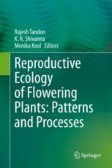Search
Search Results
-
Attraction of florivores and larcenists and interaction between antagonists in Senna rugosa (Fabaceae)
Florivory and floral larceny are very common antagonistic interactions in nature. Florivory can be especially harmful to species with polymorphisms...

-
Biotic interactions prior to seed dispersal determine recruitment probability of peyote (Lophophora diffusa, Cactaceae), a threatened species pollinator-dependent
Seedlings recruitment is key to maintaining populations and depends on diverse biotic interactions and abiotic factors before and after seed...

-
Florivory can facilitate rain-assisted autogamy in a deceptive tropical orchid
Florivores and rainfall generally have negative impacts on plant fecundity. However, in some cases, they can mediate fruit set. Some plants face...

-
Trade-offs between deer herbivory and nitrogen competition alter grassland forb composition
Two of the major factors that control the composition of herbaceous plant communities are competition for limiting soil resources and herbivory. We...

-
Does florivory affect the attraction of floral visitors to buzz-pollinated Solanum rostratum?
Floral herbivory (florivory) can directly and indirectly affect plant reproduction through the loss of ovules or seeds and by reducing the visitation...

-
Review on flower-visiting behaviour of orthopterans and setting priorities for further studies
The importance of pollination and pollinators is easy to underestimate and impossible to overstate, since its importance goes far beyond the crop...
-
Exploring the co-operativity of secretory structures for defense and pollination in flowering plants
Main conclusionIn flowers multiple secretory systems cooperate to deliver specialized metabolites to support specific roles in defence and...

-
Floral biology of Passiflora urnifolia Rusby in the Yungas rain forest of Argentina
Passiflora urnifolia is a poorly known species that is distributed in five countries in the centre of South America. In Argentina, it grows in the...

-
Multi-integrated genomic data for Passiflora foetida provides insights into genome size evolution and floral development in Passiflora
Passiflora is a plant genus known for its extremely distinctive and colorful flowers and a wide range of genome size variation. However, how genome...

-
Olfactory Cues as Functional Traits in Plant Reproduction
Floral scents are important traits which mediate interactions within biotic communities. These volatiles perform diverse functions, ranging from...
-
Accessibility and resource quality drive flower visitation patterns among native perennial species
Pollinators navigate a complex and dynamic nutritional landscape while foraging for floral resources. Bees are a group of flower-visiting insects...

-
Effects of climate change on plant-pollinator interactions and its multitrophic consequences
There is wide consensus that climate change will seriously impact flowering plants and their pollinators. Shifts in flowering phenology and insect...

-
Role of Biotechnology and Combinatorial Chemistry Approaches in Molecular-Assisted Engineering of Plant Volatile Compounds
Plants produce a wide range of volatile compounds, which plays a crucial role in their growth, development, and interactions with the environment. In...
-
Unveiling the reproduction of Proteopsis argentea (Asteraceae): how the complex pollination system might influence its conservation status
The reproductive success of organisms depends on the positive and negative interactions it establishes throughout its lifetime. Pollinators and...

-
Micropropagation of 2-methoxy-4-vinyl phenol rich Flemingia strobilifera and assessment of genetic and biochemical fidelity by SCoT and GC-MS analysis
Flemingia strobilifera is a rare phytochemically sound ethnomedicinal plant with a rich source of 2-Methoxy-4-vinyl phenol (2M4VP), a medicinally and...

-
Ancognatha vulgaris (Melolonthidae, Cyclocephalini): a specialized pollen-feeding scarab associated with wax palms (Ceroxylon spp., Arecaceae) in Andean cloud forests of Colombia
With 22 species, Ancognatha is the fourth most species-rich genus of Neotropical cyclocephaline scarabs (Melolonthidae, Cyclocephalini), an important...

-
Biology of Floral Scent Volatiles in Ornamental Plants
Floral scent has fascinated humans since antiquity and since then played a major aesthetic and commercial role in our lives. Yet, the principal...
-
A novel O-methyltransferase Cp4MP-OMT catalyses the final step in the biosynthesis of the volatile 1,4-dimethoxybenzene in pumpkin (Cucurbita pepo) flowers
BackgroundFloral scents play a crucial role in attracting insect pollinators. Among the compounds attractive to pollinators is 1,4-dimethoxybenzene...

-
Rice physical defenses and their role against insect herbivores
Main conclusion Understanding surface defenses, a relatively unexplored area in rice can provide valuable insight into constitutive and induced...

-
Influence of sexual dimorphism and dichromatism on reproductive success in a rare native cactus
Identifying plant sexual dimorphic traits is critical in advancing our knowledge on plant–pollinator interactions. For example, dimorphism in floral...

